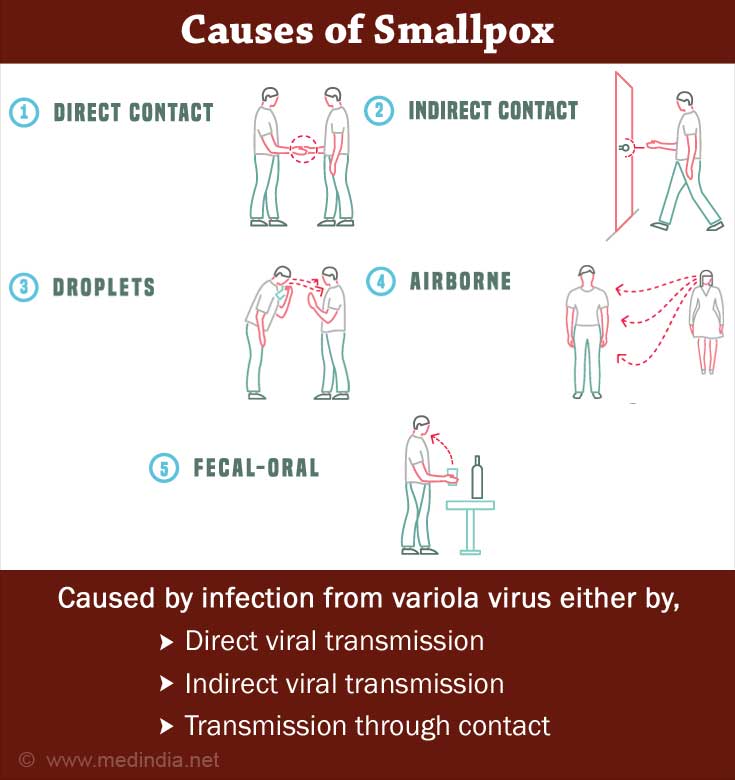- Park's, K. (2021). Park's textbook of preventive and social medicin - (http://103.38.12.142:8081/jspui/handle/123456789/355)
- Global Commission for the Certification of Smallpox Eradication, & World Health Organization. Global Commission for the Certification of Smallpox Eradication. (1980).The Global Eradication of Smallpox: Final Report of the Global Commission for the Certification of Smallpox Eradication, Geneva, December 1979 (No. 4). World Health Organization. - (http://103.38.12.142:8081/jspui/handle/123456789/355)
- World Health Organization. (2009). Weekly Epidemiological Record, 2009, vol. 84, 38 [full issue]. Weekly Epidemiological Record= Relevéépidémiologiquehebdomadaire,84(38), 385–396 - (https://apps.who.int/iris/bitstream/handle/10665/241423/WER8438.PDF)
- Smallpox - (https://www.cdc.gov/smallpox/index.html)
- Variola Virus (Smallpox) - (https://www.centerforhealthsecurity.org/our-work/publications/smallpox-fact-sheet)
- Smallpox - Overview - (https://www.who.int/health-topics/smallpox#tab=tab_1)
- Smallpox - Symptoms & Causes - (https://www.mayoclinic.org/diseases-conditions/smallpox/symptoms-causes/syc-20353027)
- About Smallpox - (https://my.clevelandclinic.org/health/diseases/10855-smallpox)
- History of Smallpox - (https://www.historyofvaccines.org/timeline/smallpox)
What is Smallpox?
Smallpox is a deadly contagious infection that is caused by the variola virus (member of the orthopoxvirus family). However, the devastating, acute disease was eradicated long back in 1980 with collective efforts of global immunization campaign.
History of Smallpox
Smallpox has been known to be the crippling cause of mortality among humankind for thousands of years. It is reported that the disease might have existed as early as 300 CE in Europe.
Although the exact origin of the disease is not clear, there have been findings suggestive of its existence (smallpox-like pustules on the head) on the 3000-year-old Egyptian mummy of the Pharaoh Ramses V (died 1157 BCE) as per the World Health Organization (WHO).
The earliest written description of smallpox was coined in the common era (4th century) in China and Asia Minor in the 10th century. The ancient Sanskrit medical texts (1500 BCE) have also referred to smallpox-like illness and later encounters in India during the 7th century.
As the civilizations’ growth and trade routes expanded over the centuries among various countries, the global spread of the dreadful disease became more protuberant by the 18th century.
The disease has haunted humankind with its use between 1754 and 1767 as a biological weapon during the French and Indian Wars. Moreover, British soldiers have also used the virus as they circulated smallpox-infected blankets to American Indians. The Soviet Union had also developed an aerosol biological weapon of variola in the 1980s via intercontinental ballistic missiles.
The earliest approach for containing the spread of smallpox was variolation (named after the causal viral agent) — which refers to the process of inoculating oneself (through scratching) with sores of smallpox into the arm or nasal inhalation. This resulted in naturally building up the acquired immunity against the killer disease.
What are the Causes of Smallpox?
Smallpox is primarily caused by a viral infection from two closely related strains of variola virus — variola major and variola minor. General routes of transmission are:

- Direct viral transmission from person to personvia air droplets, coughing, sneezing, or talking
- Indirectly viral transmission from an infected person via ventilation system of the building, or rooms
- Transmission through contact with contaminated items like clothing or bedding
What are the Symptoms and Signs of Smallpox?
The characteristic symptoms of smallpox are described in the following phases:
- The Incubation Period (7–19 days): Generally asymptomatic and non-infectious
- Initial Symptoms (2–4 days): Contagious phase characterized by early and pustular rash and scabs. Other symptoms like high-grade
fever , headaches, body aches, and vomiting may occur. - Early Rash (lasts 4 days): Most contagious phase is characterized by a fever followed by red spots in the mouth, tongue and subsequent spread to the throat and breaking into the body skin within 24 hours (starting from face to the arms and legs followed by hands, feet, and trunk).
- The sores form into a scab with bumps (thick, opaque-filled fluid with a dent in the center) by 4th day.
- Pustular Rash and Scabs (lasts 10 days): Contagious phase characterized by pustules formation (sores become round and sharply raised with firmness on touch), followed by crust and scab formation.
- Shedding of Scabs (lasts 6 days): Contagious phase characterized by scabbing off most of the rashes, and formation of skin marks.
- After nearly 4 weeks, all the scabs fall off, and the person remains non-contagious at this phase.
How do you Diagnose Smallpox?
Typical symptoms and signs of smallpox, along with other history, are the keys to the diagnosis of the disease.
Smallpox Vaccination Drive
The initial drive for vaccination began in 1796 by Dr.Edward Jenner. He remarked on the variolation process as he noticed that milkmaids infected with cowpox were immune against smallpox.
Jenner further tested the ideology by inoculating the cowpox sore from a milkmaid Sarah Nelmes into the arm of his gardener’s 9-year-old son, James Phipps.
After a few months, Jenner exposed the variola virus multiple times to the boy (Phipps). To his surprise, Phipps did not develop smallpox.
Following this success through various experiments, Jenner published his work — “On the Origin of the Vaccine Inoculation” in 1801, wherein he conveyed hopes that “the annihilation of smallpox, the most dreadful scourge of the human species, must be the final result of this practice.”
This instigated the worldwide practice of vaccination (that gradually replaced variolation), and in the 1800s, the vaccinia virus was utilized to prepare smallpox vaccine (rather than cowpox virus).
Surveillance Against Smallpox
The WHO initiated the strategy against smallpox in 1959. Despite this, the widespread outbreaks of smallpox in 1966 demanded rather renewed efforts via Intensified Eradication Program in 1967.
The establishment of a case surveillance system followed by mass vaccination led the way for steady progress against ridding with the disease. In 1971, smallpox was eradicated from South America, in 1975 from Asia, and finally in 1977 from Africa.
How can you Treat Smallpox?
Although certain antiviral drugs may help treat smallpox, there is no complete cure or treatment against the disease. Infected people are generally isolated to control the viral spread and diminish the disease severity.
The only effective and beneficial way to prevent smallpox is routine vaccination that may render immunity up to 3 to 5 years or longer (in case of revaccination).

The available smallpox vaccines by Strategic National Stockpile (SNS) are:
- Live, replication-competent vaccine ACAM2000®— Single percutaneous dose for active immunization against high-risk groups for smallpox. However, it has potential risks that may outweigh its benefits.
- Replication-deficient modified vaccinia Ankara vaccine (JYNNEOS, also known as Imvamune and Imvanex) — Safe, and recommended for those with weak immune systems.
- Aventis Pasteur Smallpox Vaccine (APSV) — Investigational replication-competent vaccinia virus vaccine intended for Emergency Use Authorization (EUA).
What are the Complications of Smallpox?
Smallpox may not always be fatal. Generally, people survive with proper measures taken against it. However, in rare cases, the diseases may be fatal, especially among pregnant women and those with impaired immune systems.
Other complications of smallpox include severe scarring and even blindness.
Last Smallpox Case
The last case of smallpox in India was documented on 24th May 1975, and India was finally declared free of smallpox on 5th July 1975. The smallpox eradication was confirmed by an international commission in April 1977 followed by confirmation of global eradication of smallpox on 8th May 1980 by the 33rd World Health Assembly.
Rahima Banu, a 3-year-old female child from Bangladesh, was reported to be the last case of smallpox caused by variola major in 1975. And Ali Maow Maalin was reported to be the last case of smallpox caused by variola minor in 1977. The last person to die from smallpox was Janet Parker in 1978 — a medical photographer at England’s Birmingham University Medical School.
However, the reserve stock of variola virus and smallpox vaccination continues to be maintained at the Centers for Disease Control and Prevention in Atlanta, Georgia, and the State Research Center of Virology and Biotechnology (VECTOR Institute) in Koltsovo, Russia, under the WHO supervision for research purposes and emergency crisis.
This also raises concerns among some regarding the re-use of it as a serious bioterrorist threat.









